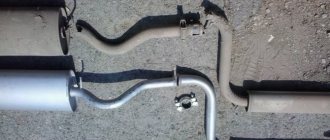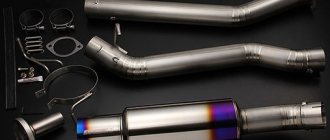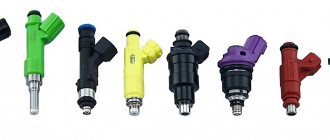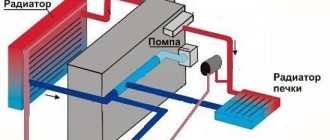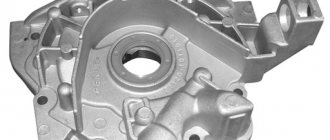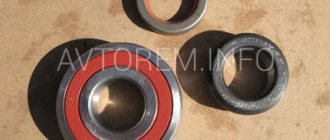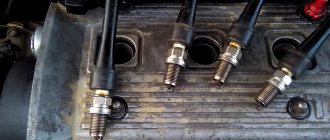Standard elements of the exhaust system of a VAZ 2104 passenger car last from 30 to 50 thousand kilometers. Then the problems begin - due to wear, the preliminary and main muffler tanks burn out. Symptoms of the malfunction are noticeable without any diagnosis - the breakthrough of gases through the fistulas is accompanied by an unpleasant roaring sound. Replacing worn parts is not difficult for an experienced motorist; beginners are advised to first study the design of the Zhiguli exhaust tract.
- Exhaust tract design
- Main muffler - device and types
Video: how to make a forward flow yourself
- What tool will you need?
Video: how to replace the muffler yourself
- Video: repairing exhaust using sealant
- Video: how to replace the resonator on classic VAZ models
Exhaust system design of VAZ 2107
Like most passenger cars, the VAZ 2107 has an exhaust system consisting of three main parts:
- a receiving pipe into which gases enter from the exhaust manifolds;
- VAZ 2107 resonator (additional muffler), where gases are directed from the exhaust pipe and where the exhaust sound is partially reduced;
- muffler, which absorbs most of the engine exhaust noise.
In addition to the above parts, the exhaust system includes:
- muffler mounting pad;
- pillow bolt;
- muffler suspension belt;
- clamp bolt and clamp securing the muffler to the resonator;
- clamp bolt and clamp securing the resonator to the exhaust pipe;
- clamp bolt and clamp securing the exhaust pipe to the body;
- nuts securing the exhaust pipe to the manifold;
- pad;
- locking plate;
Types of products
You can buy the following types of mufflers for the domestic brand:
- assembly model “Izh-Auto”, which is suitable for VAZ 2104, 2106 and 2107;
- model for a sedan body, which is suitable, in addition to the VAZ 2107, on varieties 2101, 2103, 2105 and 2106.
The following types of exhaust systems are available on the market:
stamped and welded. They involve stamping two metal parts of the product can, welding them and attaching them to the pipe. Initially, exhaust systems were made in this way, but then the more reliable rolling method replaced it;
sunset Involves wrapping sheet metal around the muffler. Despite the reliability of the method, factory parts are made only by the first method, so you can purchase roll-up exhaust systems separately.
Differences between the exhaust systems of carburetor and injection VAZ models
Installation of an injection system on a VAZ 2107 required modernization of the exhaust system. Two additional details were added to it:
- an oxygen sensor that determines the composition of the mixture, which is embedded in the exhaust manifold;
- an exhaust gas catalyst (“catalyst”), which is installed in front of the resonator, in the central tunnel under the bottom.
In connection with the installation of the catalyst, the VAZ 2107 resonator (injector) was moved a little back.
The new exhaust system has become a little more complicated, but it allows for a reduction in the toxicity of the VAZ 2107 exhaust and ensures that the car complies with EURO-2 standards.
Advantages and disadvantages of the injection modification of the VAZ 2107
The “Seven” in injection version and with a modernized exhaust system has a number of advantages over the old “carburetor” model. They are as follows:
- thanks to the injector, the engine operates more stable in all modes;
- the specific power and torque of the injection engine are higher;
- the exhaust of a VAZ 2107 with an injection system is cleaner than smoke from a carburetor engine;
- Driving a car with an injection engine is easier, it is not so demanding on the driver’s qualifications and “forgiven” mistakes when operating the gas and clutch pedals.
But installing the injector at the same time worsened some performance characteristics:
- the clearance of the injection “seven” decreased to 7 cm, which worsened its cross-country ability;
- due to the installation of the catalyst, the “survivability” of the exhaust system has decreased;
- the high temperature of the catalyst sometimes causes grass and dry leaves to ignite when the car is stopped.
Exhaust system functions and parts replacement intervals
Despite its apparent simplicity, the exhaust system performs several important functions:
- removal of fuel combustion products;
- reduction of noise level from the exhaust;
- maintaining air balance in intake and exhaust systems;
- ensuring ventilation and cleaning of cylinders;
- reduction of CO content (in the presence of a catalyst).
Exposure to high temperatures, moisture, fuel and oil combustion products leads to through corrosion of exhaust system parts. This is aggravated by the external influence of gravel, sand and salt solutions that are used to treat roads in winter. Therefore, parts of the system have to be changed. The frequency of replacement depends on the following factors:
- car use activity;
- frequency of machine operation in bad weather (rain, snow);
- fuel quality;
- quality of exhaust system parts.
Replacing the muffler VAZ 2107
The VAZ 2107 muffler (injector and carburetor) is connected to the resonator with a clamp, which is located in front of the rear axle. Before removing the clamp, it should be tapped with a hammer to make it easier to unscrew the threaded connection and uncouple the pipes. To change the muffler, you need to do the following:
- loosen the clamp bolt and remove (move) the clamp;
- pull the flared muffler pipe off the resonator (if that doesn’t work, knock it down with a hammer and chisel);
- remove the muffler from the cushion and mounting straps;
- install a new muffler on the VAZ 2107;
- tighten the clamp.
Removal process
In the process of removing an element of the exhaust system from a VAZ 2107 (injector) for its subsequent replacement. The following tools will be useful to you:
- wrench 13 (open-end type);
- ratchet or crank;
- deep heads on 13 and 10;
- Bulgarian;
- flat screwdriver (can be replaced with a chisel);
- pliers;
- hammer.
To figure out how to remove the muffler from your VAZ correctly and replace it. Please read the following instructions carefully:
- install the car over an inspection hole or on an overpass;
- unscrew (cut with a grinder) the crimp coupling;
- using a screwdriver or thin chisel, bend the flared ends of the pipe;
- using a hammer, which you will use to knock on the pipe, separate the muffler from the resonator;
- Unfasten the hanging pillows.
After this, the product can be freely removed to be replaced with a new one, which is installed in the reverse order.
Please note that the connection between the muffler pipe and the resonator pipe is located in front of the rear axle. The ends of the pipe with slots and female-male fasteners are tightened using a coupling. Removal of the product can be complicated by corrosion, which develops under the influence of temperatures and lubrication.
For this reason, moisten corroded parts with an anti-corrosive agent in advance (motor oil or brake fluid will also work). If you are planning to install a new muffler, it would be a good idea to purchase new suspension rubber bands (1 for the rear and 2 for the center location).
As some drivers joke, the muffler is one of those parts that “does not affect speed.” Indeed, getting to the garage without a muffler, if this happens, is acceptable
But everyday comfortable and safe operation of a car is impossible without this important design element.
Replacing the VAZ 2107 resonator
The VAZ 2107 resonator does not have fastening parts to the car body, so it is necessary to hold it when replacing it. Otherwise the exhaust pipe will be bent.
The replacement work consists of the following steps:
- tap clamps and pipe connections with a hammer;
- loosen the bolts of the clamps and move the clamps fastening to the “pants” and the muffler;
- disconnect the resonator from the muffler by undocking the pipes;
- disconnect the resonator from the receiving pipe (“pants”);
- install the new resonator in the correct position;
- connect the parts and tighten the fastening clamps.
Note: the resonator tank must be parallel to the ground, otherwise the part will knock on the bottom of the car and cling to uneven road surfaces.
Replacing the neutralizer
As you can see, the exhaust system of the VAZ 2110 car is designed quite standardly, its repair is not difficult even for a motorist with little experience.
When changing the muffler and resonator, it is likely that you may need to replace the converter. This operation is simple and can be done in a few steps.
The neutralizer serves to dampen vibrations from the engine and prevent them from occurring in the exhaust system of the domestically produced VAZ 2110 car.
If it needs to be replaced, it is done like this:
- If the old springs and bolts are intact and have no obvious damage, you can continue to use them. They show characteristic signs of wear, be sure to buy new elements.
- The ring should be replaced in any case, no matter how well the old one is preserved. If gases begin to leak through the old ring, this will lead to very rapid wear and damage to the converter flare and the exhaust pipe.
- After installing the neutralizer, new bolts are put on, they are carefully but firmly tightened. Moreover, the first thing you need to do is tighten the bolts that secure the resonator.
Replacing the exhaust pipe (“pants”) of a VAZ 2107
When replacing the exhaust pipe, be sure to replace the gasket between it and the exhaust manifold. It is also better to change the nuts securing the “pants” to the manifold. The procedure is as follows:
- loosen the clamp and disconnect the pants from the resonator;
- unscrew the four nuts securing the exhaust pipe to the manifold;
Important: unscrew the nuts carefully so as not to twist the fastening studs. Otherwise, you will have to drill out and replace the studs.
- remove the “pants” (exhaust pipe) and gasket;
- install a new gasket;
- install a new exhaust pipe;
- connect the exhaust pipe to the resonator, tighten the fastening clamp;
- tighten the nuts securing the “pants” to the manifold.
Exhaust 2104
It's time to change the exhaust pipe and resonators. Questions arose:
1. Does the system on 2104 differ from sedans only in the muffler or also in the exhaust pipe and pipe with resonators?
2. Is it better to take a system with one resonator or two? Criteria: cheaper, last longer and have higher ground clearance. Apparently it’s better with one resonator. But won't it be a bit noisy? Is there even a pipe with one can for 2104?
3. What to take besides the pipes themselves? Two clamps, a suspension clamp for the gearbox, a gasket for the exhaust pipe. What else?
4. Is it really possible to change it yourself? Where is it more convenient to unscrew the nuts - from under the hood or from under the car?
5. The silencer seems normal. I want to leave it, is it possible to disconnect it from the pipe without an angle grinder? Surely a new pipe with resonators will fit it?
6. Which pipes by manufacturer are best to buy (Peter)?
Re: Exhaust 2104 > 1. Does the system on 2104 differ from sedans only in the muffler or also in the exhaust pipe and pipe with resonators? I don’t know > > 2. Is it better to take a system with one resonator or two? With two
> Criteria: cheaper, last longer and have higher ground clearance. It doesn't happen that way. Either it’s cheaper or it lasted longer.
> 3. What to take besides the pipes themselves? Two clamps, a suspension clamp for the gearbox, a gasket for the exhaust pipe. What else? Bronze nuts for exhaust pipe
> 4. Is it really possible to change it yourself? Where is it more convenient to unscrew the nuts - from under the hood or from under the car? Really. You need a rhombic jack - press out the engine when you pull out/put on the pipe. Unscrew the nuts from the top.
> 6. Which pipes by manufacturer are best to buy (Peter)? Walker
Why is it better with two? Just by sound? It seemed to me that a regular pipe would last longer than a pipe with a resonator.
It may turn out that a leaky exhaust system leads to unstable operation at idle?
Source of the article: https://forum.auto.ru/vaz-classic/1310763/
Exhaust System Mounting Parts
The clamps and suspension elements of the exhaust system are exposed to moisture and salt during machine operation. In addition to corrosion, metal “fatigue” accumulates in clamps. The clamps begin to loosely hold the connection, as a result of which exhaust gases begin to break out, creating noise. Old suspension cushions may break off, which can damage exhaust system parts. Therefore, it is advisable to change the mounting parts; whenever large parts are replaced, the mounting elements on which they are attached should also be changed. This will avoid unnecessary problems and expenses.
Standard elements of the exhaust system of a VAZ 2104 passenger car last from 30 to 50 thousand kilometers. Then the problems begin - due to wear, the preliminary and main muffler tanks burn out. Symptoms of the malfunction are noticeable without any diagnosis - the breakthrough of gases through the fistulas is accompanied by an unpleasant roaring sound. Replacing worn parts is not difficult for an experienced motorist; beginners are advised to first study the design of the Zhiguli exhaust tract.
Functions of the VAZ 2104 exhaust system
To get maximum energy from the engine, you need to burn the fuel under optimal conditions. The required volume of air is added to the gasoline, then the mixture is sent through the inlet manifold into the cylinders, where it is compressed by pistons 8-9 times. The result is that after the flash, the fuel burns at a certain speed and pushes the pistons in the opposite direction, the motor performs mechanical work.
In addition to the energy that rotates the engine crankshaft, by-products are released when the air-fuel mixture is burned:
- exhaust harmful gases - carbon dioxide CO2, nitrogen oxide NO, carbon monoxide CO and other chemical compounds in smaller volumes;
- a large amount of heat;
- a loud sound similar to a rumble that is formed with each flash of fuel in the cylinders of the power unit.
A significant portion of the released thermal energy is dissipated into the environment thanks to the water cooling system. The rest of the heat is taken up by combustion products that escape through the exhaust manifold and exhaust pipe.
What problems does the VAZ 2104 exhaust system solve:
- Removal of flue gases from the cylinders during the exhaust stroke - combustion products are pushed out of the chambers by pistons.
- Cooling of gases by heat exchange with ambient air.
- Suppression of sound vibrations and reduction of noise levels from engine operation.
The latest modifications of the “fours” - VAZ 21041 and 21043 were equipped with an electronically controlled fuel supply system - an injector. Accordingly, the exhaust tract was supplemented with a section of a catalytic converter that neutralizes toxic gases through chemical reduction (afterburning).
Purpose of the exhaust system
Before combustion in the engine cylinders, gasoline is mixed with air and supplied through the intake manifold into the combustion chamber. There, the mixture is compressed eight times by the pistons and ignited by a spark from the spark plug. As a result of the process, 3 components are formed:
- heat and mechanical energy that rotates the crankshaft;
- gasoline combustion products - carbon dioxide and carbon monoxide, nitrogen oxide and water vapor;
- combustion under high pressure generates sound vibrations - the same exhaust sound.
Since the efficiency of internal combustion engines does not exceed 45%, about half of the released energy is converted into heat. One part of the heat is removed by the engine cooling system, the second is carried out by the exhaust gases through the exhaust tract.
The VAZ 2107 exhaust system performs several important functions:
- Emission of combustion products from the chambers and ventilation of the cylinders after the next combustion cycle.
- Reducing the amplitude of sound vibrations, that is, reducing the noise level of a running motor.
- Removal and dissipation of part of the released heat in the atmosphere.
On “sevens” with an injection power system, the exhaust tract solves another important task - it cleans the exhaust from toxic gases CO and NO by afterburning in a catalytic converter.
This is interesting: Replacing the engine with a more powerful one - who do you need to report to?
Exhaust tract design
On all classic VAZ models, including the Four, the exhaust is designed the same and consists of three parts:
- a receiving section in the form of a double pipe is screwed to the exhaust manifold flange - the so-called pants;
- the middle part of the tract is a single pipe equipped with a resonator tank (on cars with 1.5 and 1.6 liter engines there are 2 such tanks);
- at the end of the tract the main muffler is located.
In the injection modifications of the “four”, a neutralizer tank is added, installed between the “pants” and the resonator section. The efficiency of the element is controlled by an oxygen sensor (otherwise known as a lambda probe), which sends signals to the electronic control unit.
Each part of the system performs its function. The receiving pipe dampens the primary noise, collects gases into a single channel and removes the lion's share of the heat. The resonator and the main muffler absorb sound waves and finally cool the combustion products. The entire structure is supported by 5 fasteners:
- The intake pipe is connected to the motor via a flange connection, fasteners are 4 nuts with M8 threads, made of heat-resistant bronze.
- The second end of the “pants” is screwed to a bracket located on the gearbox housing.
- The barrel of the main muffler is suspended from the bottom by 2 rubber struts.
- The rear end of the exhaust pipe is attached to the body using a rubber cushion.
The middle resonator part is not attached to the bottom in any way and is held in place only by the adjacent sections - the muffler and the exhaust pipe. This point must be taken into account when disassembling the exhaust. Being an inexperienced car enthusiast, I changed the muffler myself and, in the process of disconnecting the pipes, I broke off the clamp securing the “pants”. I had to look for and buy a new clamp.
Troubleshooting
The first problems with the gas exhaust system may begin after 20 thousand kilometers. How do muffler malfunctions manifest on the VAZ 2104 model:
- the main symptom is an increase in noise level from the exhaust pipe due to gas breakthrough; the volume of the sound depends on the size of the defect;
- the fastenings of the sound-absorbing section wear out, the tank begins to wobble and hit the body elements, while driving, a dull knock is heard from under the bottom;
Rubber products stretch over time, the muffler body begins to dangle in a horizontal plane and touch the bottom of the car. - in rare cases, the pipe becomes clogged with soot, preventing the flow of gases, the engine stalls and will no longer start;
- Failure of lambda probes on cars with an injector leads to over-enrichment of the fuel mixture, a sharp increase in gasoline consumption and malfunctions during the operation of the power unit in all modes.
Receiving signals from the lambda probes, the electronic control unit regulates the supply of fuel to the cylinders. When the oxygen sensor does not show signs of “life”, the controller goes into emergency mode and dispenses fuel “blindly”, following the programmed program. Hence the excessive enrichment of the mixture, jerking while driving and other troubles.
The catalyst is an expensive element, so owners of “fours” replace it with a straight piece of pipe
A clogged muffler or catalyst leads to complete failure - the engine refuses to start. My friend searched for a long time for the reason when he encountered this problem on his “four”. I changed spark plugs, high-voltage wires, measured the pressure in the fuel rail... and the culprit turned out to be a clogged converter - the ceramic honeycombs were completely clogged with soot. The solution turned out to be simple - instead of an expensive element, a straight section of pipe was installed.
The lower burnout of the housing indicates condensation that has accumulated at the bottom of the tank
The most common problem with a muffler is burnout of the tank or pipe connection secured with a clamp. Causes of malfunction:
- Aggressive condensate accumulates in the muffler can, gradually corroding the metal. Due to the effects of chemical corrosion, many small holes are formed in the bottom wall of the tank, where smoke breaks through.
- Natural wear of the section. From constant contact with hot combustion products, the metal becomes thinner and breaks through in a weak spot. Usually the defect appears near the welded joint of the pipe and the tank.
- Mechanical damage to the can from an external impact or as a result of fuel burning out inside the exhaust manifold. In the latter case, a loud bang is heard from the pipe; sometimes the shock wave can tear the muffler body at the seams.
A burst muffler is a consequence of problems in the ignition or gas distribution system - the remaining fuel burns in the exhaust tract
The most harmless malfunction is the breakthrough of gases at the junction of the muffler and resonator pipes. The exhaust noise increases slightly, but if no action is taken, the volume gradually increases. The fastening of the joint weakens, the resonator section begins to sag and touch the protrusions of the road surface.
A clear sign of gases escaping at the junction of the exhaust pipes is the flow of condensate that breaks through along with the smoke when the car’s engine has not yet warmed up to operating temperature.
A fistula at the junction of the pipes can be identified by wet traces of condensation
Main muffler - device and types
The factory-made element is made of refractory “black” steel and coated with a layer of anti-corrosion paint. The part consists of 3 parts:
- front pipe, curved to bypass the rear axle;
- three-chamber muffler tank with a system of partitions and pipes inside;
- outlet pipe with a bracket for mounting a rubber cushion.
At the end of the front pipe there are slots for connection to the resonator. The connection is fixed from the outside with a clamp, a tightening bolt and an M8 nut.
The mufflers for “classics” sold today are not reliable - spare parts are often made from second-rate metal and burn out after 15-25 thousand kilometers. It is quite difficult to identify a low-quality part when purchasing; the only way is to visually check the quality of the welds.
In addition to the factory version, other types of mufflers can be installed on the VAZ 2104:
- element completely welded from stainless steel;
- sports (direct-flow) option;
- a homemade section with a round cistern made from a thin-walled iron pipe.
A stainless steel exhaust element will cost 2-3 times more than a factory part, but can last up to 100 thousand km. I was convinced of this personally when I bought and installed a stainless exhaust system on my VAZ 2106 - the design is identical to the exhaust tract of the V4. I happily forgot about the pipe burnouts for several years.
The direct-flow type of muffler differs from the standard part in its operating principle. Gases pass through the perforated pipe and do not change the direction of movement, the resistance of the section is zero. Result: it is easier for the engine to “breathe”, but the noise is suppressed less well - the operation of the motor is accompanied by a rumbling sound.
If you are “friendly” with a welding machine, the factory version of the muffler can be modified or the element can be made from scratch. In home-made products, the principle of direct flow is implemented, since welding a flat tank with partitions is much more difficult - it is easier to buy a ready-made part. How to make a main muffler with your own hands:
- Select pipes for the outer casing and direct-flow channel. As a tank, you can use a round muffler from a Tavria, or take a curved front pipe from an old section from a Zhiguli.
- Make an internal perforated pipe by drilling holes Ø5-6 mm and making through slots with a thin circle on the metal.
The final stage of manufacturing is painting the part with a heat-resistant composition. After installing any muffler - factory or homemade - the protruding end of the pipe can be refined using a decorative nozzle, fixed from the outside with a locking screw.
Video: how to make a forward flow yourself
What is important to know about the resonator
Structurally, the pre-muffler is identical to the forward flow described above - a straight perforated pipe passes through the cylindrical body. The only difference is the partition that divides the tank space into 2 chambers.
Resonator tasks:
- dampen primary sound vibrations of large amplitude;
- facilitate the work of the main muffler and extend its life;
- remove some of the heat from the flue gases.
The principle of operation of the element is based on the physical phenomenon of resonance - repeatedly reflecting from the partition and the inner walls of the can, sound waves cancel each other out.
The VAZ 2107 car is equipped with 3 types of resonators:
- The classic option for carburetor engines, used in the first models with an injector, is a long pipe with one or two banks (depending on engine size).
- On injection models that comply with Euro 2 exhaust standards, a shortened resonator section with a flange was installed at the front end of the pipe. The catalytic converter was bolted to it.
- After the introduction of Euro 3 standards, the length of the catalyst increased and the length of the resonator decreased. The section for the injection version of the “seven”, which meets these requirements, is equipped with a front flange with 3 bolts.
When operating resonators, the malfunctions described above occur - burnouts, rust and mechanical damage. Troubleshooting methods are similar to repairing a muffler - welding or temporary sealing with a bandage. Removing the resonator section is not difficult - you need to unscrew the fastening to the gearbox, then disconnect the muffler and “pants” pipes. On a VAZ 2107 with an injector, the flange is disconnected instead of the front clamp.
Repair and replacement of muffler section
When fistulas are detected in the element body, experienced drivers prefer to contact a familiar welder. The technician will check the thickness of the metal and immediately give an answer - whether the defect can be eliminated or whether the entire part will have to be replaced. The burnout of the bottom of the tank is welded directly on the car; in other cases, the muffler must be dismantled.
Without welding equipment or sufficient qualifications, you will not be able to weld a fistula yourself; you will have to buy and install a new spare part. If you can see many small holes in the wall of the barrel, eaten away by corrosion, there is also no point in contacting a welder - the metal is probably rotten, there is no need to grab a patch. It’s easier to change the muffler yourself and not pay for a fairly simple operation.
What tool will you need?
To disconnect the pipes and remove the muffler, prepare the following tools:
- 2 socket wrenches size 13 mm;
- open-end wrench 10 mm;
- pipe wrench No. 3, designed for reliable gripping of round parts measuring 20...63 mm;
- mechanic's hammer;
- pliers;
- slotted screwdriver with a wide tip;
- fabric gloves.
Consumables will require a new set of rubber hangers (a cushion and 2 stretchers with hooks) and WD-40 aerosol lubricant, which greatly facilitates the unscrewing of stuck threaded connections.
It is recommended to carry out work on a pit, overpass or car lift. Lying under the car, it is very inconvenient to disconnect the muffler from the resonator - due to the lack of free space, you will have to use your bare hands, it is unrealistic to swing and hit with a hammer.
I had to disassemble a similar VAZ 2106 exhaust system on the road. Since I couldn’t separate the pipes by hand, I jacked it up as much as possible and removed the right rear wheel. Thanks to this, it was possible to disconnect the pipe by hitting it 3-4 times with a hammer.
Disassembly instructions
Before starting work, drive the “four” into the inspection ditch and let the car cool for 15-30 minutes. The exhaust system parts get quite hot from the exhaust gases and can burn your palms even through gloves.
When the muffler has cooled, apply WD-40 lubricant to the joint and bolt of the mounting clamp, then proceed to disassembly:
- Using two 13 mm wrenches, unscrew the nut and loosen the mounting clamp that holds the resonator and muffler pipes together. Move the clamp to the side.
Using a wide screwdriver, you need to unbend the edges of the stuck pipe, and then loosen the connection with your hands, holding the resonator with a gas wrench. If the above methods do not help, simply cut the pipe with an angle grinder.
Installation of a new spare part is carried out in reverse order. Here it is important to push the muffler pipe all the way, otherwise the exhaust tract elements will begin to hit the bottom or the resonator section will sag. Lubricate the threaded connections with grease.
Video: how to replace the muffler yourself
Elimination of minor defects
In the absence of welding, a small fistula in the muffler can be temporarily repaired using a high-temperature ceramic sealant. A special composition for repairing exhaust pipes is sold at any automobile store. Additionally, you will need the following consumables:
- tin 0.2…0.5 mm thick;
- degreaser - white spirit, galosh gasoline;
- rags;
- a brush with metal bristles, coarse sandpaper, metal scissors.
A piece of tin can be cut from a galvanized profile used for installing plasterboard systems.
Before sealing the fistula, it is advisable to remove the muffler, otherwise you risk missing other defects. An exception is sealing the holes in the bottom of the can; in this case, it is not necessary to dismantle the section. How to properly close a fistula:
- Using a brush and sandpaper, clean the defect area from dirt and rust. The operation allows you to level the surface and maximize the location of the damage.
- Prepare a tin clamp - cut a strip to the size of the defect.
When the sealant has hardened, start the engine and make sure there are no gases escaping. Repair with a bandage is a temporary measure, the patch is enough for 1-3 thousand km, then the muffler still burns out.
Video: repairing exhaust using sealant
Purpose and design of the resonator
The structure of the resonator is similar to a direct-flow muffler - a perforated pipe is laid inside the cylindrical body without any partitions. The difference lies in the jumper that divides the jar into 2 resonator chambers. The element performs 3 functions:
- perceives and pre-damps sound waves;
- dissipates part of the heat coming from combustion products;
- Extends the service life of the main muffler.
When operating, a two-chamber tank uses the principle of resonance - sound vibrations are repeatedly reflected from the walls, collide with oncoming waves and cancel each other out. The VAZ 2104 was equipped with 3 types of sections:
- Cars with a carburetor power system were equipped with a long resonator for 2 tanks. For the modification with a 1.3 liter VAZ 2105 engine, an element with 1 can was installed.
Damage and malfunction of the resonator cans are similar to the main muffler section. During operation, housings and pipes burn out, rust or break due to external influences. The repair methods are identical - welding, temporary bandage or complete replacement of the part.
Video: how to replace the resonator on classic VAZ models
Over the years, it has become more difficult to find high-quality spare parts for domestic cars that have long been out of production. Practice shows that it is better to repeatedly repair the original factory muffler than to buy a part of unknown origin that will literally fall apart after 10 thousand km. The second reliable option is to incur financial costs, but install a durable stainless steel exhaust pipe.
What does the price depend on?
To manufacture the body and tubes of high-quality components, special stainless and heat-resistant steels are used, designed to operate under constant thermal load with sudden temperature changes. These mufflers last longer, but they are the most expensive. Spare parts made of aluminized steel or aluminum-zinc will also last a long time. To reduce the cost, “ferrous” alloys are sometimes used.
The larger the muffler volume, the better. Other factors that increase the service life and increase the cost of the unit are thicker walls and complex internal design, as well as additional thermal protection.
Resonator
Purpose and design of the muffler for VAZ 2104–2107 cars
Exhaust gases escape from the engine cylinders under high pressure and with loud noise. The muffler receives and slows down gases, converts their kinetic energy into thermal energy, smoothes out pulsations and muffles the sound, then releases the weakened exhaust into the atmosphere.
Thus, among the main functions of the muffler:
- reduction of engine noise;
- conversion of exhaust gas energy;
- safe release of gases into the atmosphere.
In everyday life, a muffler is called an exhaust tract or exhaust system. In fact, it is only one, albeit the most important, element of the fuel system. For VAZ cars with a classic layout, it consists of a reception pipe connected to the engine exhaust manifold, an additional (resonator) and a main muffler.
For VAZ cars with a classic layout, the exhaust gas system consists of a reception pipe connected to the engine exhaust manifold, an additional and main muffler
All of the above is located under the bottom of the car. The system elements - pipe, resonator and muffler - are attached to each other with clamps. The exhaust pipe is rigidly screwed to the manifold and the gearbox cover, the main muffler body is suspended from the body by rubber straps, and the exhaust pipe is suspended by a rubber cushion.
At the Politburo, the Minister of Automotive Industry Alexander Mikhailovich Tarasov made a report in which he spoke about the state of affairs in the automobile industry and spoke about the need to build a new plant using foreign experience, and Dmitry Fedorovich Ustinov, the former head of the Ministry of Defense, who oversaw issues of the military-industrial complex, objected, that having such a “defense industry”, it costs nothing to build a new plant on our own. And then Kosygin proposed building two factories - one using Soviet “patterns”, and the second - with foreigners. The idea was accepted, and as a result, two with a capacity of 220,000 cars per year and a VAZ with an annual capacity of 660,000 cars appeared.
Innokenty Kishkurno
Wheels
Where is it located and how does it work?
The muffler is installed on the underbody of the vehicle at the end of the exhaust system.
As a rule, a resonator is installed in front of it, closer to the engine, which reduces low-frequency vibrations and plays the role of an additional component in the exhaust system.
Despite the seemingly small size of the device, the sound wave travels through it for several kilometers. This is achieved by the presence of labyrinths inside the muffler, which attenuate sound waves.
The further a wave travels, the more energy it loses and the smaller the sound becomes.
To understand what a muffler consists of, you need to understand what types of devices there are and how they differ from each other.
Replacement and repair of muffler for VAZ 2104–2107 cars
To replace the muffler you will need:
- inspection hole or lift;
- screwdriver;
- a set of car keys;
- hammer.
Removing and installing the muffler
To dismantle the “glushak”, repair it, and then return it to its place, follow this sequence of actions:
- Drive the car into the inspection hole. Stop the engine and turn off the ignition. Wait until the exhaust manifold cools down.
- Unbend the hooks of the rubber suspension straps of the muffler.
Using a screwdriver, straighten the hooks of the rubber straps on which the muffler is suspended
Unscrew the exhaust pipe fastening to the rubber cushion with a wrench
Loosen the clamp between the pipes of the main and additional muffler
Carefully knock the resonator out of the mount by hitting it with a hammer through a wooden spacer
Unscrew the exhaust pipe from the gearbox bracket
Carefully bend the stoppers and unscrew the exhaust pipe from the manifold
Install the new muffler in the opposite order of removal. However, do not use a used gasket. Before assembly, treat the pipes at the places where they are connected with clamps with graphite lubricant.
Video: replacing a VAZ 2107 muffler in a garage
In 1979, at VAZ, a car was built especially for “dear Leonid Ilyich,” which received the common name “half past six.” This happened after the presentation of the VAZ-2105 and 2107 models to the country's leadership, the serial production of which was still quite far away, and Brezhnev wished to give such a car to one of his family members. The result was a unique car, the body and interior of which was a hybrid of a “six” and a “seven” - hence the name.
Innokenty Kishkurno
Wheels
How to adjust the gap between the valve and the cylinder block?
- We use a probe with a thickness of 0.15 (mm). It should fit under the valve with a slight tension (neither strong nor weak). If the dipstick falls into the gap or, on the contrary, does not fit, then from this moment the adjustment of the valves on the VAZ 2105 begins.
- We loosen the lower lock nut with one key, and with the second key we turn the valve stroke screw (up or down, depending on the result of checking with the feeler gauge).
- Tighten the locknut without much fanaticism.
- We do a control check with a feeler gauge at 0.15 (mm).
I hope the instructions are clear and understandable.
Related material: Replacing engine oil and oil filter on Lada Priora. Which oil to choose and how often to change
Additional Information
After adjustment, we assemble all the engine elements into place (valve covers, timing belt cover, air filter housing).
We make a test drive and listen to the sound. At this point, independent maintenance of timing valves can be considered successfully completed.
Please note that the VAZ 2105 is a classic of the bygone Soviet automobile industry. The classic line also includes the VAZ 2101, VAZ 2102, VAZ 2103, VAZ 2104 and VAZ 2106. Starting with the VAZ 2107, cars use an injection system for preparing the combustible mixture
That is, seven is no longer a classic. The procedure for adjusting valves 2105, as well as 2101, 2102, 2103, 2104 and 2106, is completely the same. That is, the classics are configured according to the same principle.
Starting with the VAZ 2107, cars use an injection system for preparing the combustible mixture. That is, seven is no longer a classic. The procedure for adjusting valves 2105, as well as 2101, 2102, 2103, 2104 and 2106, is completely the same. That is, the classics are configured according to the same principle.
Starting from the VAZ 2107, you need to configure the timing in a different way. Valve adjustment on the VAZ 2107 is carried out at a more subtle level. Only a properly qualified car mechanic can handle this work. Without solid experience in handling vehicles, it’s better not to go into the timing belt of VAZs, starting with the seven. It’s easier to take the car to the nearest service station.
I hope the article on how to adjust valves on a VAZ 2105 was useful. Have smooth roads and fewer breakdowns.
- Necessary tool
- Signs of poor valve clearance
- Procedure for checking valve clearance
- Adjusting valve clearance
- Video on the topic: Do-it-yourself valve adjustment on a Zhiguli
A feature of VAZ cars belonging to the “Classic” category, namely the VAZ-2101-2107 model, is the use of power plants that are structurally very similar. The engines of these models differ mainly in some technical characteristics. Thanks to this, many perform maintenance and repair work themselves.
For stable operation of the power unit of these cars, periodic adjustment of the valves is required. It is worth noting that this operation for VAZ “Classic” engines is performed by adjusting the gap between the valve drive lever and the camshaft cam. Since this operation is performed in the same way for different models on the Classic, let’s consider the sequence of work using the example of one model - VAZ-2105
The adjustment can be carried out both on a cold engine and on a warm one; for this, a 0.15 or 0.20 mm probe is used, respectively.
But for more precise adjustment of the valves, work must be carried out on a cold engine.
How are knocking and muffler position related?
If the muffler suddenly starts knocking on some parts of the car, find the source of the extraneous sounds. Usually the reason lies in stretched rubber fasteners. After replacing them, the knocking will stop.
Sometimes a knock appears after work related to removing the muffler. In this case, extraneous sounds are a consequence of installation errors. Round pipes at the joints with clamps can be slightly rotated relative to the correct position: more or less than required, pushed into each other.
To eliminate knocking, restore the optimal position of the exhaust system elements.
Sagging mufflers can be “treated” using similar methods—by replacing rubber bands and correcting the position of joints.
Video: repairing a sagging VAZ 2106 muffler
The nuances of muffler repair
The muffler of “classic” VAZ cars, according to the manufacturer’s recommendations, cannot be repaired. If a malfunction occurs in any element of the exhaust tract, the part must be replaced with a new one.
In fact, motorists often prefer to repair holes burned in the muffler - the most common defect - by welding.
The occurrence of “fistulas” is indicated by a change in the sound of the engine and the appearance of smoke from under the car. To troubleshoot, place the machine on a platform and inspect the elements of the exhaust system.
If the cause is a burnt gasket, remove the muffler and replace it. When you have an assistant, you can do without removing all elements of the system. Proceed in the following order:
- Unscrew the pipe fastening to the gearbox.
- Unscrew the nuts securing the exhaust pipe to the manifold.
- Together with an assistant, pull the “pants” off the pins while simultaneously rotating the bend of the resonator pipe.
- Replace the gasket, install the pipe in place, tighten the fasteners.
Replacing a burnt muffler gasket eliminates extraneous sounds from the engine
A welded muffler usually lasts less than a new one. But welding is also cheaper than buying. Usually, if it is necessary to repair a muffler by welding, they turn to professionals. If you have the equipment, you can do the work yourself. For this you will need:
- welding machine;
- blanks for patches made of sheet metal 1–2 mm thick;
- a piece of pipe of the same diameter as the failed one;
- grinder with cutting disc for metal;
- metal brush;
- sandpaper;
- heat-resistant paint for metal.
To repair the muffler, follow this sequence:
- Remove the muffler from the vehicle.
- Using an external inspection, determine the location of the malfunction and the extent of the damage.
- If there is a large hole in the muffler body, evaluate the condition of the internal parts. It is possible that repairing the external surface will not bring the desired restoration of the functions of the muffler without replacing the internals. In this case, it is advisable to contact professionals or simply replace the faulty part with a new one.
- Cut out the burnt area. From the blank, make a patch larger than the damage. Weld the patch over the hole with a continuous seam.
- If there is damage at the junction of the pipe and the muffler body, cut out the defective area, replace the damaged part of the pipe, and weld the repaired pipe to the muffler with a continuous seam.
- Clean the repaired muffler from dirt and rust, paint the part with two layers of heat-resistant paint.
Photo gallery: muffler welding
Video: repairing a VAZ muffler by welding
Replacing and repairing a muffler is a dirty and time-consuming job. But there is nothing complicated about it. You never know what you can do till you try.
